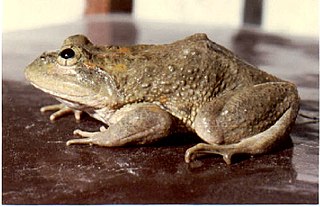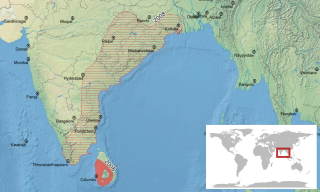
Ombrana is a monotypic genus of frogs in the family Dicroglossidae. It is represented by a single species, Ombrana sikimensis. The validity of this genus is currently considered uncertain.

The Doichang frog is a species of frog in the family Dicroglossidae. It is only known from its type locality, Doi Chang, mountain north of Chiang Mai (Thailand), Fansipan mountain in northern Vietnam, and Huanglianshan National Nature Reserve in Yunnan, China.
The Tonkin Asian frog is a species of frog in the family Dicroglossidae. Based on its known distribution, it is endemic to northern Vietnam, although it is considered likely that it also occurs in adjacent Laos and China. This poorly known species is presumed to be associated with small streams. Possible threats include collection for human consumption and habitat loss.
Quasipaa yei, or Ye's spiny-vented frog, is a species of frog in the family Dicroglossidae. It is endemic to China where it is known from the Dabie Mountains that straddle the border between Hubei, Henan, and Anhui provinces. Its type locality is in Shengcheng County in Jiyuan City, Henan. Its natural habitats are temperate rivers with surrounding forests. It is potentially threatened by habitat loss.

Minervarya pierrei is a species of frog in the family Dicroglossidae. It is found in Nepal, adjacent India, and eastern Bangladesh. It has recently been reported also from Bhutan. It is a common species associated with paddy fields.

Limnonectes microtympanum is a species of frog in the family Dicroglossidae. It is endemic to Sulawesi, Indonesia, where it is only known from the Moncong Lompobatang mountain at elevations above 1,000 m (3,300 ft).
Nanorana arnoldi is a large species of frog in the family Dicroglossidae. It is found in southwestern China, northern Myanmar, eastern Nepal, and adjacent northeastern India. Its natural habitats are subtropical or tropical moist montane forest, rivers, and freshwater springs. It is primarily threatened by collection for consumption, but also by habitat loss.

Quasipaa exilispinosa is a species of frog in the family Dicroglossidae. It is known under many common names, including Hong Kong spiny frog, common spiny frog, lesser spiny frog, little spiny frog, and Hong Kong paa frog. It has a patchy distribution in southern China including Hong Kong. Its natural habitats are subtropical hill streams in forests or shrublands, and sometimes also seepages, stream-fed marshes, and forests. It is threatened by over-collecting for human consumption and by habitat loss.
Quasipaa fasciculispina is a species of frog in the family Dicroglossidae. It is known under many common names: spiny-breasted giant frog, spiny-breasted frog, spine-glanded mountain frog, and Thai paa frog. It is found in the Cardamom Mountains in southwestern Cambodia and eastern Thailand. It is found in on near fast-flowing mountain streams in tropical evergreen forests. It is threatened by collecting for human consumption and by habitat loss.
Quasipaa jiulongensis is a species of frog in the family Dicroglossidae. It is endemic to eastern China and only known from the mountains of southwestern Zhejiang and adjacent Fujian above 800 m (2,600 ft) elevation. Its natural habitats are hill streams. It is threatened by habitat loss due to both logging and infrastructure development as well as by collection for food.
Quasipaa robertingeri is a species of frog in the family Dicroglossidae. It is endemic to Southwest China and is known from southeastern Sichuan, Chonqing, and northern Guizhou. It is named in honor of Robert F. Inger, an American herpetologist and ichthyologist. Common name Hejiang spiny frog has been proposed for it.

Nanorana rostandi is a species of frog in the family Dicroglossidae. It is endemic to western Nepal. It is a rare species found near high-altitude streams, springs, and other running waters within forests and grasslands. It is threatened by habitat loss due to subsistence wood collecting.
Quasipaa shini is a species of frog in the family Dicroglossidae. It is endemic to southern central China. Its natural habitats are rivers in subtropical moist lowland forests and montane forest at elevations of 510–1,500 m (1,670–4,920 ft) asl. It is threatened by over-collecting for human consumption and by habitat loss.

Quasipaa spinosa is a species of frog in the family Dicroglossidae. It is known under many common names, including Chinese spiny frog, giant spiny frog, Chinese edible frog, and spiny paa frog. Its names refer to the distinctive characteristics of the species, relatively large size and the spiny chest of male frogs. Giant in frog terms only, it can nevertheless grow to lengths above 10 cm (4 in); this makes it the largest frog in Hong Kong.

Chrysopaa is a genus of frogs in the family Dicroglossidae. It is monotypic, being represented by the single species, Chrysopaa sternosignata. It is found in Balochistan, Pakistan, Kashmir and in Afghanistan. Its common names include Baluch Mountain frog, karez frog, Malir paa frog, and Murray's frog.

Quasipaa verrucospinosa is a species of frog in the family Dicroglossidae. It is found in Laos, Vietnam, and Yunnan, China. It occurs in and around streams in hill and lower montane evergreen forests. It is believed to be relatively common, but it is threatened by collection for consumption and—presumably—habitat loss driven by logging, causing degradation of forest habitat and stream sedimentation.

Sphaerotheca rolandae is a species of frog in the family Dicroglossidae found in Sri Lanka. It is controversial whether the species also occurs in India and Nepal. Its natural habitats are subtropical or tropical dry forest, subtropical or tropical dry shrubland, intermittent freshwater marshes, arable land, and pastureland. It is threatened by habitat loss.

The frog family Dicroglossidae occurs in tropical and subtropical regions of Asia and Africa, with most genera and species being found in Asia. The common name of the family is fork-tongued frogs.

Allopaa is a small genus of frogs in the family Dicroglossidae. Their distribution is restricted to Kashmir region of India and Pakistan. The phylogenetic placement of this genus has not been addressed with molecular methods and remains uncertain.
Quasipaa acanthophora is a species of frog in the family Dicroglossidae. It is endemic to northern Vietnam and know from two locations, its type locality Mau Son in the Lang Son Province, and the Tay Yen Tu Nature Reserve in the Bac Giang Province. It is a sibling species of Quasipaa spinosa.











